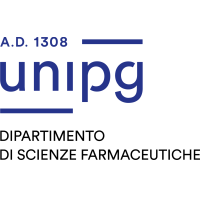List of services for third parties available at the Department's facilities and laboratories
A) ANALYSIS AND TESTS
1. Development and validation of a quantitative analysis method of a substance of pharmaceutical, nutraceutical or cosmetic interest, through HPLC / DAD or HPLC / ELSD or GC / MS analysis.
2. Development and validation of a quantitative analysis method of a substance of pharmaceutical, nutraceutical or cosmetic interest, not registered in F.U./Ph.Eur., Through UV-Vis spectrophotometry analysis.
3. Determination by HPLC / DAD analysis of the chemical purity of substances of pharmaceutical or nutraceutical interest, obtained through synthesis or extraction procedures
4. Determination by UV-Vis spectrophotometry analysis of the chemical purity of substances of pharmaceutical interest described in F.U./Ph.Eur.
5. Execution of essays reported in the monographs of the F.U./Ph.Eur.
6. Evaluation of the characteristics of pharmaceutical containers - glass release tests
7. Evaluation of the characteristics of the containers for pharmaceutical use - tests for the transfer of plastic materials
B) EXTRACTIVE PROCEDURES
1. Development of a process for extracting a natural principle, already described in the literature:
2. Development of an extraction process of a natural principle, not described in the literature:
C) FORMULATIONS
1. Formulation of solid or liquid pharmaceutical forms:
a) Spray Drying Test with Spray Dryer
b) micronization of powders (max 200 mg)
c) micronization of powders (max 200 mg) and granulometric analysis
d) micronization of powders (max 200 mg) and SEM analysis
2. Formulation of solid or liquid pharmaceutical forms containing principles consisting of phyto and opotherapeutic extracts:
3. Formulation of semi-solid pharmaceutical forms:
D) DESIGN OF PHARMACEUTICAL FORMS
1. Design and production of protracted release pharmaceutical forms
2. Design and implementation of therapeutic systems
E) STABILITY
1. Study of the stability of a pharmaceutical or cosmetic preparation by means of natural and accelerated aging tests:
F) TECHNOLOGICAL DETERMINATIONS
1. Particle size determinations:
a) sieve method
b) "Single Particle Optical Sensing" method
(triplicate analysis)
2. Determination of the density of the powders of pharmaceutical interest (tap density)
3. Determination of the zeta potential
4. Determination of viscosity:
a) with flat-cone method
5. Determination of the dissolution rate "in vitro" according to Pharmacopoeia methods:
6. Calorimetric thermal analysis with DSC821
G) DOCUMENTATIONS
1. Documentation for the technical-analytical control of medical-surgical devices according to ministerial provisions:
2. Technical analytical documentation complete according to the criteria established by the Ministry of Health for the registration of a medicinal specialty:
H) FOOD - ENVIRONMENT ANALYSIS
1. Acidity, volumetric method
2. Fatty acids, composition%
3. Total alkalinity
4. Aliphatic alcohols
5. Ammonia
6. Starch
a) enzymatic-colorimetric method
b) enzymatic-chromatographic method
7. Nitrogen
a) total nitrogen
b) mineral nitrogen (nitric + ammoniacal)
c) ammoniacal nitrogen
8. Antioxidant capacity
a) ORAC method
b) ABTS essay
c) DPPH test
9. Total organic carbon
10. Cellulose
11. Ashes
12. Waxes
13. Chlorides
14. Amino acid composition, chromatographic method
15. Protein content
16. Chrome VI
17. Diacylglycerols
a)% content of classes 1,2 and 2,3
b)% content of the isomeric classes, 1.2 - 2.3 - 1.3
18. Total hardness
19. Permanent hardness
20. Dry extract
21. Fenoli
a) total phenols, spectrophotometric
b) phenols, fractions, spectrophotometric, each
c) phenols, chromatographic characterization
22. Fiber
a) raw fiber
b) fractionated fiber
23. Plant protection products
a) monoresidual HPLC method
b) monoresidual HPLC method with LCMS confirmation
c) multiresidual HPLC method
d) multiresidual HPLC method with LCMS confirmation
e) monoresidual method GC
f) monoresidual GC method with GCMS confirmation
g) multiresidual method GC
h) multi-residual GC method with GCMS confirmation
24. Phospholipids, stereospecific analysis, each fraction
25. Hydrocarbons
a) C <12 hydrocarbons
b) C> 12 hydrocarbons
26. Spectral indices of UV lipid matrices
27. Total lipids, extraction
28. Nitrite
29. Nitrates
30. Number of p-anisidine
31. Number of peroxides
a) volumetric method
b) FOX method (ferrous oxidation / xylenol orange)
32. pH
33. Sample preparation: preliminary treatment, extraction, purification, derivatization; each phase
34. Protein quality: Chemical Index (aminogram for HRGC and index calculation)
35. Residual at 110 ° C
36. Residual at 180 ° C
37. Residual at 110 ° C + Residual at 180 ° C
38. Sulphates
39. Sterols
40. Stigmastadieni
41. TBARS (thiobarbituric acidreactive substances)
42. Triacylglycerols
a) RP-HPLC analysis
b) acidic composition in position sn-2
c) stereospecific analysis
43. Moisture, drying
44. Birds
a) SPME
b) Purge and trap
45. Vitamins
a) vitamin C, HPLC
b) vitamin A (retinol and β-carotene), HPLC
c) vitamin E and its vitamers (α, β, γ, δ tocopherols), HPLC
46. Sugars
a) volumetric method
b) chromatographic method
I) NUTRITIONAL EPIDEMIOLOGY
1. Assessment of the state of nutrition
a) Anthropometric survey
b) Survey of food habits and consumption
c) Dosage vitamins, each
2. Diet processing
L) GENERAL ANALYTICAL TECHNIQUES
1. HPLC analysis
2. HPLC-MS analysis
4. HRGC analysis
5. HRGC-MS analysis
7. UV-VIS spectrophotometric analysis
8. Volumetric analysis
9. Analysis of elements in atomic absorption and atomic emission, each
10. Analysis of elements in atomic absorption and atomic emission, subsequent to the first
11. Analysis of elements using a hydride generator or graphite furnace
12. X-ray dust diffraction, spectral pattern
13. X-ray powder diffraction, qualitative interpretation
14. Diffraction of X-ray powders
Quantitative analysis, structural determinations
15. Combined Thermogravimetric Analysis / Differential Thermal Analysis
16. Elementary analysis by plasma emission spectroscopy (ICP-OES), first 5 elements
17. Elementary analysis by plasma emission spectroscopy (ICP-OES), subsequent elements
18. Sample preparation (dissolution, mineralization, etc.) for ICP-OES
19. Air sampling, single analyte
M) NMR ANALYSIS
1. Standard 1H-NMR in CDCl3 / DMSO - 200 MHz
2. Standard 13C-NMR in CDCl3 / DMSO - 200 MHz
3. 1H-NMR standard in CDCl3 / DMSO - 400 MHz
4. Standard 13C-NMR in CDCl3 / DMSO - 400 MHz
5. DEPT standard in CDCl3 / DMSO - 200 MHz
6. DEPT standard in CDCl3 / DMSO - 400 MHz
7. Additional portion for standard analysis in different solvents
8. Additional quota for variable temperatures (-80 ÷ + 130 ° C)
9. Hourly cost for unconventional analysis (only 400 MHz)
10. Heteronuclei analysis (31P, 19F, 77Se)
11. Analysis of other heteronuclei
12. Multidimensional analysis only 400 MHz
13. GPx camouflage activity (based on the oxidation of the DTT in D2O) 200 MHz
14. GPx camouflage activity (based on DTT oxidation in D2O) 400 MHz
15. GPx camouflage activity (based on the oxidation of the DTT in MeOD) 200 MHz
16. GPx camouflage activity (based on the oxidation of the DTT in MeOD) 400 MHz
17. Interpretation of spectral data, standars analysis and reports for each analysis
N) MICROBIOLOGICAL ANALYSIS
1. Yeast strains with presumptive identification (1 to 10)
2. Yeast strains with molecular identification (1 to 10)
3. Yeast strains with presumptive identification (11 to 100)
4. Yeast strains with molecular identification (11 to 100)
5. Yeast inoculum (5 l, density> 5 * 10 ^ 6) without molecular id (1:10)
6. Yeast inoculum (5 l, density> 5 * 10 ^ 6) without molecular id (11: 100)
7. Yeast inoculum (5 l, density> 5 * 10 ^ 6) with molecular id (1:10)
8. Yeast inoculum (5 l, density> 5 * 10 ^ 6) with molecular id (11: 100)
9. Ad hoc isolation of yeasts without molecular classification
10. Molecular classification / strain only one marker (1 to 10)
11. Molecular classification / strain only one marker (11 to 100)
12. Molecular classification / strain two markers (1 to 10)
13. Molecular classification / strain two markers (11 to 100)
14. FTIR / strain metabolomic characterization (1 to 10)
15. FTIR / strain metabolomic characterization (11 to 100)
16. FTIR / strain metabolomic characterization (101 to 1000)
17. Viability of LSA and other preparations (plate method); randomly
18. Viability of LSA and other preparations (coloring method); randomly
O) TEST OF CYTO-TOXICITY, GENO / ANTIGENOTOXICITY, APOPTOSIS
1. Cytotoxicity test:
In vitro LDH test (cell lines)
2. Genotoxicity:
a) Comet assay in vitro (cell lines)
b) In vitro micronucleus test (cell lines)
c) Comet assay in vivo (hepatocytes, colonocytes, mouse brain cells)
d) In vivo micronucleus test (mouse medullary pre-erythrocytes)
3. Cyclocellular / apoptosis:
a) In vitro cell cycle (DAPI, ...)
b) Early apoptosis in vitro (mitochondrial membrane potential, ...)
c) Late in vitro apoptosis (DNA fragmentation, annexin V, caspase, ..)
P) OTHER SERVICES
1. Technical-scientific report


